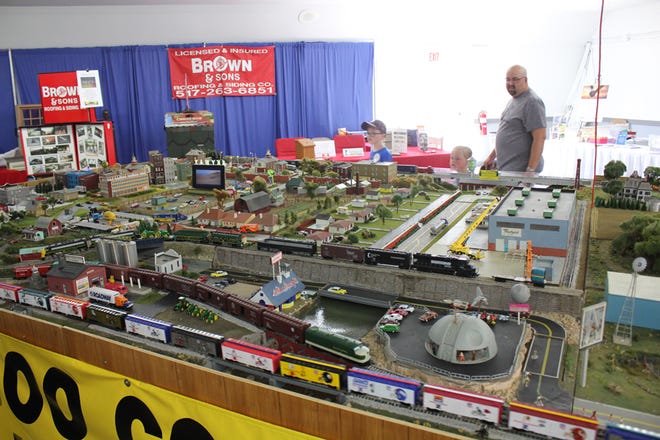Creating a model train set is thrilling, akin to constructing a personal empire and breathing life into it by controlling all the desired features. What is the typical expenditure on a model railway?
The cost of model trains can vary significantly based on brand, scale, and level of detail. Basic starter sets may range from $50 to $200, while more intricate locomotives and cars can cost $100 or more each.
Expect to spend up to $10,000 on a basement floor for a design spanning 1×2 meters. The project’s final cost will be influenced by factors such as design and construction approach.
Tracks, scenery, buildings, and accessories expenses should be factored into your budget to create a realistic model train layout that reflects your vision. Planning carefully and prioritizing your spending is essential to maximize your investment in this beloved hobby.
The Model Train Cost Examined
The first thing you’d learn when making model railroads is that they can be as cheap or as expensive as you want. The cost will also come down if you can construct the needed parts instead of buying everything. If you’ve accumulated some parts over the years or have somewhere to get them at a fraction of the market price, it all adds up to lower costs for model railroad scenery.
Generally, you should expect to spend around $300 to $400 per square foot for a quality N-scale tabletop railroad of around 1 x 2 meters (3.28 x 6.56 ft). The estimate includes quality building kits, scenes, DCC controls, two dozen turnouts featuring under-table switch machines, etc. The setup should accommodate 6-8 DCC locomotives and 50-60 rail cars under computer control, including the popular Durango & Silverton train set.
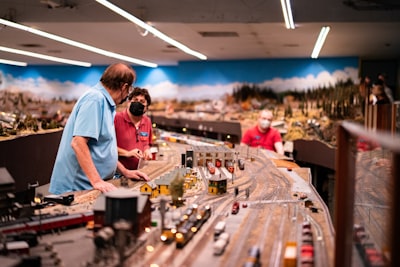
So assuming $300 to $400 per square foot, you can expect to spend around $8,000 to $10,000 on the construction. However, you should remember that N-scale is a costly model often favored by hard-core enthusiasts. It has more miniature world expenses per square foot than other models.
If you want to build a small model railroad for a child without a single train and little or no whistles and bells, you can put together a decent unit for less than 10% of the cost of an N-scale variant of the same size.
Items To Purchase for a Model Railroad Construction
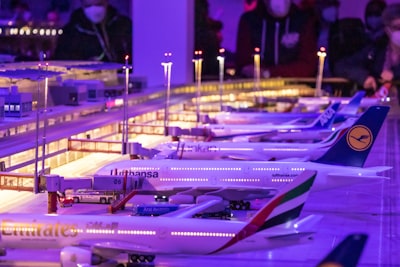
When building a model railroad, you should include the following in your construction:
- Base Board.
- Track (curves, straights, and points).
- Electronics (wires, point motors, and power controllers).
- Model buildings (bridges, house, station).
- Scenery (paint, trees, ballast, grass).
- Rolling stock (the train set including passenger carriage and goods wagon).
Of all the above expenditure points, you have the most flexibility on the train set, scenery, and buildings. You can splurge as much as you want to get as close to the real-life experience as possible or only stick to the basics.
How To Save Money on Your Model Railroad Construction
It feels like maintaining the modern railroad hobby is very costly these days. However, it doesn’t have to be. Here are a few tips you can work with to keep costs down to manageable levels.
Plan Your Construction
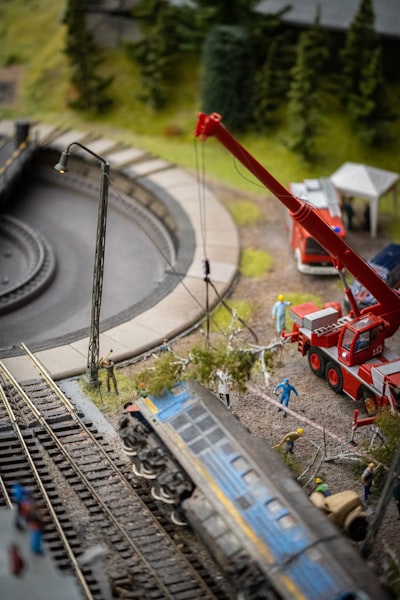
Many people make the initial error of diving into constructing a model railroad without a thorough grasp of their objectives. It is essential to have a detailed plan in place, encompassing the following aspects:
- The size of your room.
- The size of your model railroad area.
- The railroad theme.
- The scale of your construction.
- The track style.
As you put together the above details, you’ll have a clearer picture of the total cost. Compare the expected costs to your budget and make adjustments where necessary.
While some scales seem to be more expensive than others, eventually it all comes down to the details. That means you could find some parts of scale O which are more expensive than those of scale HO, while some parts are less expensive.
Shop Around Extensively
Regardless of the size of your construction, you can save more money by shopping around for parts and finding them when they’re on sale. Check online and in high-street stores for the parts you’re looking for.
Avoid shopping for parts in the summer or close to the winter holidays. You can find bargains between February and April and during widely publicized sales windows (Black Fridays, etc.).
Draw Up Your Priorities
Model railroading is a hobby with different meanings to different people. You can keep costs down by focusing on the areas that appeal to you the most. For instance, if you love the buildings more than the tracks, you can focus on building compact and detailed dioramas or train layouts instead of spending money on a larger layout.
Similarly, it’s important to stick to your chosen theme once you’ve settled on one. Chopping and changing or incorporating features from another theme is a great way to waste more money and spend more time than necessary on the construction process.
Go the DIY Route
People spend too much money on modern railroads because they can buy almost everything they need. When you can buy almost any part you need in a box, you’re likely to order parts you won’t need “just in case.” Apart from inflating the cost of your purchase, it also dampens the excitement and sense of accomplishment that comes with the construction.
Even when you’re buying the exact quantities of parts you need, you still have to pay the markups on prices. A good way to go is to use DIY kits for your locomotives, freight cars, and buildings. They still cost money, but you’d save a fraction of the cost and still enjoy constructing the railroad on your own. Another option is to search for deals on eBay and other internet sites, allowing you to bring down the cost of purchasing trains and materials.
If you have the right skills, you can save even more money and complete your construction from scratch. True aficionados can build tracks, scenery, trains, and buildings from scratch with the right raw materials. This approach gives you even better flexibility with your layout.
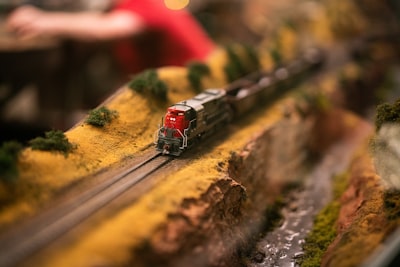
Buy Inexpensive Units and Customize to Your Taste
Instead of buying a $100 train car, you can buy a $20 option and then customize it to your taste. Again, customization requires you to have the right skills, but it’s an excellent way to save money. Small details like adding better wheels, coupler, decals, and a new lick of paint can transform that cheap model railroad accessory into a high-end one—at least in appearance. You can also save money by purchasing used or discounted steam locomotive models, which can be customized to your liking. Plus, sign up for our email list to receive 10% off your purchase today!
Choose Between Quantity and Quality
To keep the cost of your model railroad down, you have to consider what matters most to you in the construction. Do you really need so many train cars?
If you prefer long trains, you can go with inexpensive kits that yield the same visual results. There’s no need to spend money on extremely detailed train lines. Some of the hyped-up features are relegated to the background once the train gets going anyway.
On the other hand, if you’re more interested in appreciating individual train car models, you can buy a few high-quality options instead of spending money on too many inferior options.
The argument stretches to other elements, including the scenery design. How many trees and buildings do you need? Do you need multiple bridges for your design or just one long unit? It all comes down to what you need and how you intend to stretch out your budget.
Join a Community
Most model railroad clubs will charge membership fees. However, the cost pays for itself over time. You’ll feel the benefits a lot more when it’s time for new construction. You’ll learn from other modelers, and you may get free help with your construction.
Additionally, some of the community may have parts you can reuse. This way, you can save money or free up a portion of your budget to be used elsewhere. Find a decent-sized community around you or online and register with them.
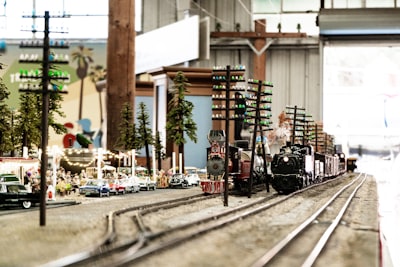
Sell Old Parts to Finance New Ones
Do you have parts from older railroad constructions you can’t reuse? You can sell them off and raise some cash to finance the budget for the new design.
You’re only likely to make back a fraction of the money you spent originally because model trains and their accompaniments aren’t the best investment. Even slightly used or “new in the box” items won’t fetch back anywhere near the original cost. However, if you derived some value from the parts, any amount you get back is a nice-to-have that can help you save a bit more money on your new construction.
Buy Used Parts
As you’re looking for new parts for a new project, other people are also thinking the same. Therefore, there’ll always be used parts to buy on the market. Search online for used versions of the parts you need. Once you find them, do your homework and conduct inspections as you would when buying any other used items. You could also repair some parts to make them usable.
You should avoid buying used parts like transformers and locomotives from faceless people online. Buy from a store that will allow you to test the product before purchase or one that has a return policy and honors it. You need the return policy with online stores the most. Don’t get swayed by nice-looking pictures.
Repurpose Old Items in Your Home
When you’re building a model railroad, you’ll have many opportunities to repurpose older materials around the home instead of buying something new. For example, you can use some old fencing lumber for your benchwork or use foam from an old cushion for your scenery. You can also cut up some old artificial grass to add to the scenery. Sawdust shavings from your woodwork shop can also serve as the woodchip for your hopper car.
Spread Out Your Construction
As mentioned above, some items you’ll need for a model railroad construction will go on sale periodically. Spreading out your construction timeline will allow you to save money by only buying items when they’re on sale, such as during holiday sales. It shouldn’t be too hard to extend your timeline because most large-sized constructions often take years if you’re building from scratch. Don’t forget to sign up for the TrainWorld newsletter to stay updated on special discounts, holiday sales, pre-order announcements, new releases, and more! Creating an account also has additional benefits such as seeing order and shipping status, tracking order history, and checking out faster.
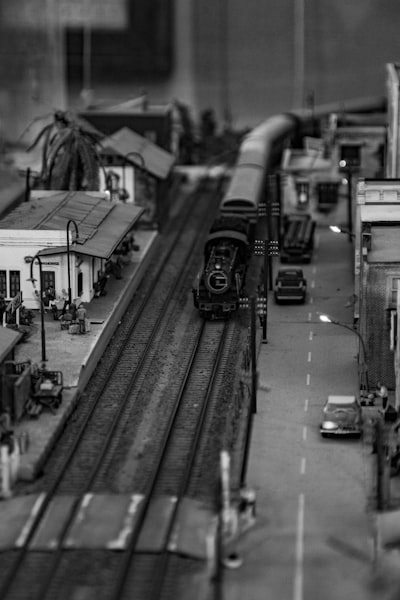
How To Choose the Right Model Train Set
The best way to choose the right model train set is to pick one that’s appropriate for the user’s age. You should already have users in mind when building your railroad, so you can pick your model train accordingly.
Choosing a Model Train Set for Children
If you’re building a railroad for your children, you should choose options that’ll retain their interest while also allowing you to expand the railway in the future. Ideally, you should choose a set that has at least a point or two. Children will get bored quickly if the train only goes round in a loop or just stops then goes back in the opposite direction. So, choose a train set that incorporates sidings and offers free shipping for added convenience.
To make the most of your sidings, it’s a good idea to buy a freight set that has an assortment of wagons. This way, you can move wagons from one siding to the other. Wagons give your children something to do as they can load them up with Lego bricks, soldiers, etc. Avoid passenger train sets as children find them boring.
Choosing a Set for Adults
If you’re building your model railroad with adults in mind, you should choose train sets with a high level of detail and gauge. Most enthusiasts will pay attention to the quality and gauge of the trains. A freight set may also work here, but most adults won’t care. The best-detailed units can qualify as ornaments when the railroad is out of commission. Some popular brands for high-quality and detailed train sets for adults include Kato, Lionel Trains, and Intermountain.
Choosing Between DC and DCC Train Sets
One of the biggest decisions you’ll have to make when choosing a train set is the method of powering and control. DC train sets feature Directional Current while DCC variants have Digital Command Control.
Train sets with DCC control systems typically provide more flexibility. They remove the complexities associated with having more than one train on your modern railroad. The one problem with choosing DCC units is that you have to go through a learning curve to avoid a head-on collision on your track. DC train sets are recommended for less elaborate model railroads.
FAQs
What Are the Right Model Train Scales for Adults and Children?
The best scale for kids is N-scale. For adults, HO and O scales are recommended. Children older than ten years old may be big enough to appreciate the O and HO scales.
The N-scale works well for small kids because of the size, but as mentioned above, N-scale railroads are often costly. You also have to be mindful of choking hazards. Some parents go straight to the HO section when building a railroad or buying train sets for kids.
The HO scale is the perfect middle ground because adults can also appreciate them. The units are big enough and can contain a lot of detail. The scale is also the most popular around, so you can find all the elements you need to fit out your model railroad.
What Are the Best Model Train Brands in the US?
The best model train brands in the US are:
Walthers and Athearn’s products come in the N and HO scale. Atlas makes theirs in the O, N, and HO scale, while Bachmann makes products in the HO, N, and G scale. Arnold (a subsidiary of Hornby UK) makes only N scale products, while Lionel only makes O scale products.
What’s the Best Way to Sell or Exchange Old Model Railroad Products?
The best way to sell or exchange your old model railroad products is online on classified ads websites. You may also post messages online on model train communities. Alternatively, you can seek out offline shows and events to see if you find willing buyers or exchange seekers.
If you use classified ads websites or online communities, you need to heed all the standard warnings to avoid losing your items without receiving any money back.
Another good place to sell or exchange your old railroad products is at your local store. If they offer swaps, exchanging the items for pieces you need in your construction should be straightforward.
Can You Buy Complete Ready-Made Railroads?
Many model train manufacturers also sell complete railroad sets. The sets will include the trains, the scenery, tracks, and other such fittings. However, buying such sets doesn’t leave much room for flexibility.
For example, if you buy a Christmas railroad set, it would look out of place after the holiday season. Designing and building your own railroad means you can rejig the scenery and repaint your trains at Christmas. You can also easily switch to a new design in the summer without tearing down everything.
Final Thoughts
A model railroad can cost around $300-$400 per square foot and up to $10,000 for a completed project. However, it doesn’t have to be too costly. The final cost you’ll pay comes down to your railroad’s overall theme and structure, as well as careful shopping for necessary items. For example, my most recent purchase was a Walthers FP7 Amtrak for $230 new from a local hobby shop. For efficient construction, it’s best to draft a comprehensive plan in line with your budget then slowly bring the pieces together. Final Thoughts: It’s important to consider all factors when determining the cost of a model railroad, including the specific items and themes you choose. By shopping carefully, you can save money and still create a beautiful and functional model railroad.
Don’t forget to visit the used parts market and repurpose old household items to save money. You can also sell or exchange older modern railroad units to cover some of the costs of your new construction.
